Photos: Inside the Bizarre World of the Crested Saguaro Cactus
Slow and stately
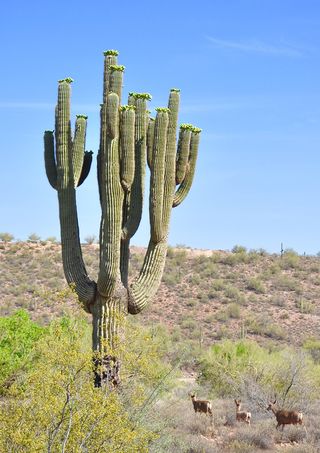
The saguaro cactus, (Carnegiea gigantea), is the iconic symbol of the American West. Even though these large, tree-like columnar cactus are slow growers, mature saguaros can grow to be 40 to 60 feet (12 to 18 meters) tall and live to be between 150 to 200 years old. Shown here is a herd of mule deer, Odocoileus hemionus, running past one of these "Monarchs of the Desert" during the springtime blooming season.
Habitat
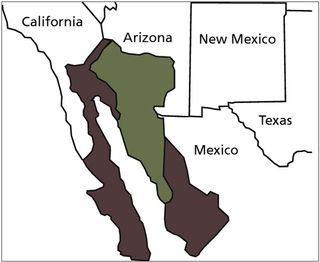
The saguaro cactus naturally grows only in the Sonoran Desert, which is indicated by the brown shading of this U.S. National Park Service map. The range of the saguaro cactus, shaded in green, is limited by the occurrence of freezing temperatures in the winter and elevation. The vast majority grow from sea level upward to nearly a 4,000 feet (1,220 m) in elevation. Those found growing above 4,000 feet are most often on a south-facing mountain slope where the warmth of the winter sun makes freezing temperature less likely.
Reaching for the sky
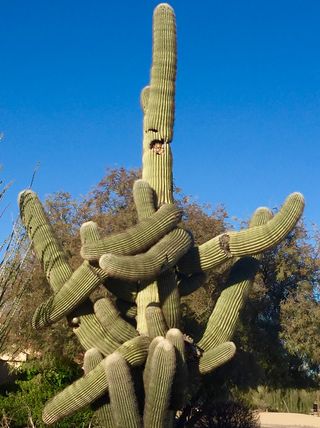
Some saguaros grow only as a singular tall column, while others produce branches or arms. Arm growth, if it occurs, seems to begin when the saguaro reaches 50 to 70 years in age. Some saguaros produce only a single arm while others, like the one shown here, have grown 16 twisting and turning arms.
Large fan
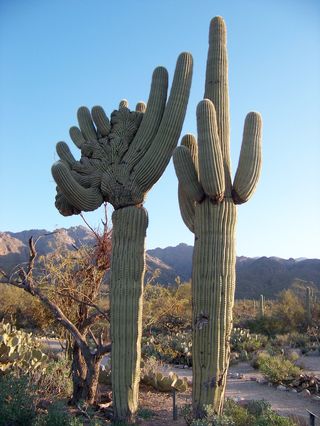
Occasionally, saguaros begin an unusual pattern of growth where the cells in the growing stems divide and grow laterally instead of their normal circular growing form. This mutation creates a large fan-like crest at the saguaro's growing tips and the saguaro is now called a cristate or crested saguaro.
Rare and unique
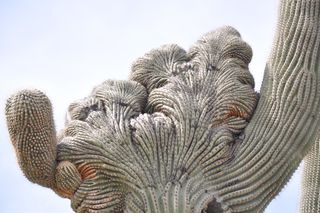
Crested saguaros are rare with only some 2,000 crested saguaros having been documented by botanists throughout the Sonoran Desert region. Many more may be growing in the more isolated and rugged regions of the desert waiting to be discovered. In Saguaro National Park near Tucson, Arizona, 57 crested saguaros can be identified and documented.
Onward and upward
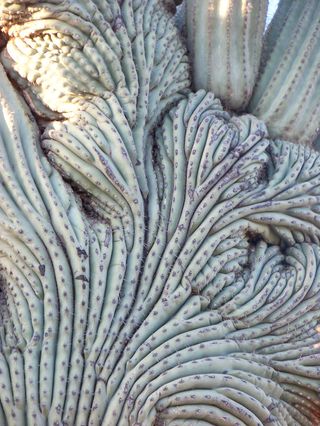
The typical crest of a saguaro tends to measure from 3 to 5 feet (0.9 to 1.5 m) across. Larger crests, upwards of 9 feet (2.7 m) in diameter, have been reported but never scientifically documented. The crests seem to grow in curved to even semi-circular patterns, creating unique and interesting natural designs.
Genetic mutation

The reasons that a saguaro cactus begins to grow a crest is not fully understood. Botanists can only speculate about what "triggers" this unusual growth pattern. Some botanists speculate that it is a genetic mutation. Others have suggested it is the result of a lightning strike. Since the majority of discovered crested saguaros are found in the northern region of the Sonoran Desert, many botanists think the "triggering event" is the freezing of the growth rings during a time of heavy frost.
Sign up for the Live Science daily newsletter now
Get the world’s most fascinating discoveries delivered straight to your inbox.
Unusual specimens

Crested saguaros carry on the normal life functions of all saguaro cacti. They will flower in the spring, produce viable seeds in the summer (as shown here) and even sprout and grow a new arm or two from the crest itself. Like all saguaro cacti, no two crested saguaros are alike.
Organ pipe cactus
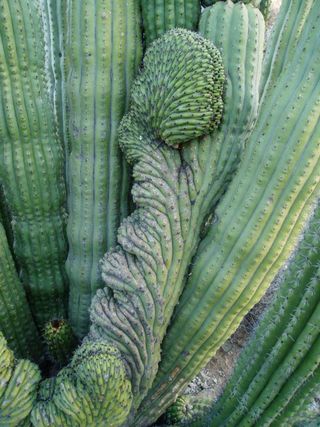
Cristate or crested growth is not unique to the saguaro cactus. Many other Sonoran Desert species of cacti can also exhibit these strange growth patterns. This photo shows the cristation of an organ pipe cactus, Stenocereus thurberi, in Organ Pipe National Monument in southern Arizona.
Strange patterns

Because they are rare, and because of their bizarre growth patterns, the crested saguaro cacti of the Sonoran Desert are always in danger from illegal cactus poachers. Strict federal and state laws against saguaro poaching and an increase in public knowledge and awareness of the potential dangers are all helping protect these unique natural desert treasures from harm.
Unique in the world
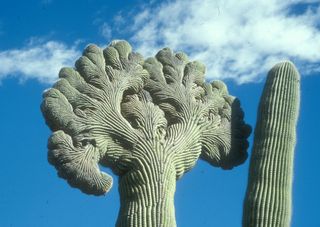
The saguaro cactus is as unusual a plant species as can be found anywhere in the world. Its ability to survive and thrive through the extreme summer temperatures of the Sonoran Desert is in itself an amazing testament to survival. And for a species often thought to be somewhat weird in appearance, the rare and twisted forms of the crested saguaro must surely be close to the top of the list of Earth's most unusual life forms.
Most Popular

